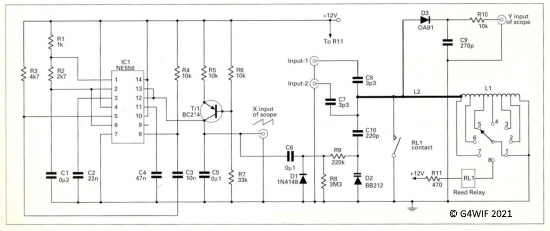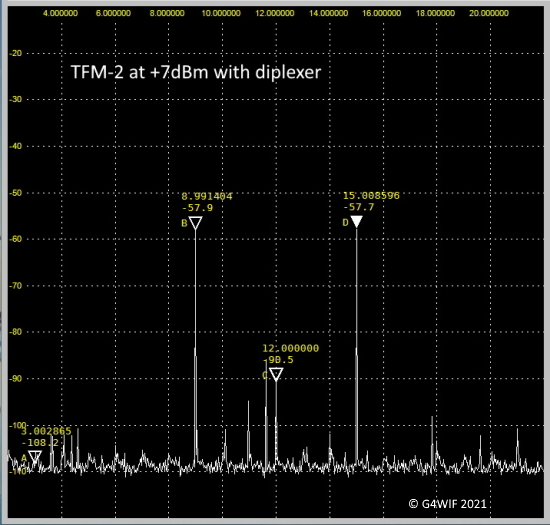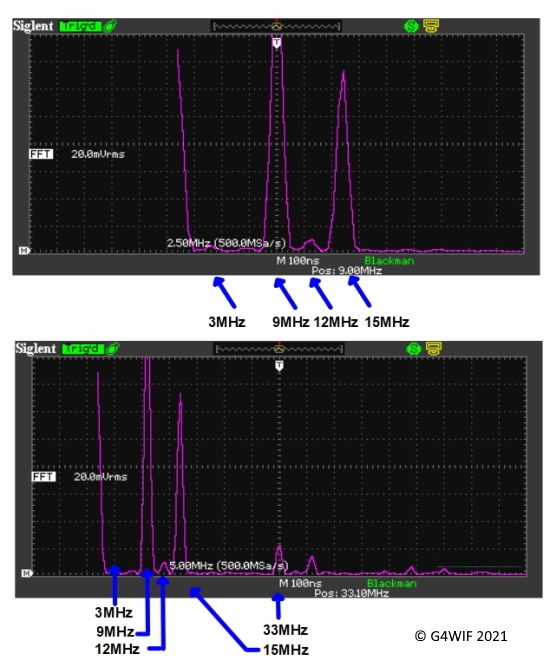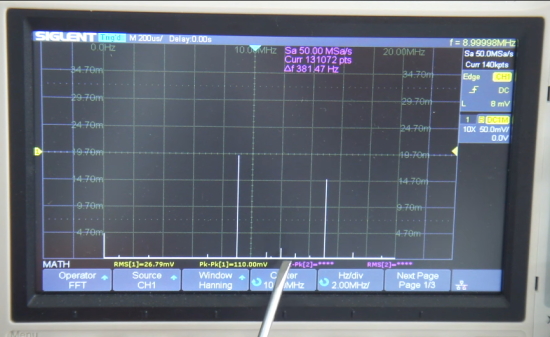Home.
May 2021 - Spectrum Analysers on the cheap
For the most part, test equipment for me has been a relatively
inexpensive adjunct to my radio hobby. Perhaps surprisingly so because
I spend most of my time building radio gear than operating it.
The process is that I take a fancy to a particular project and perhaps
take a detour to build a bit of test gear that makes the first project
possible. Often times even simple test gear is all you need.
For years I found that an old 40MHz Tektronix oscilloscope did what I
needed. No doubt there are test procedures that exceed my knowledge
that it couldn't do - but that was fine. That old scope served me for a
long time. Then it died in 2016 beyond economical repair - and after a lot of
review reading I replaced it with a Siglent SDS1102CML which was in the
budget hobby class.It has so much more capability than the old
Tektronix that I will very likely keep it as my main 'scope for many
years.

Decades ago (where did that time go?), I was converting ex-taxi radios
to work on 2 metres and I built my first device that could show signals across the spectrum. That allowed me to easily peak up multiplier stages. That
was the "Spectrum Wavemeter".
It was basically, an absorption wavemeter with a sweeping variactor
tuning.You would employ an oscilloscope to provide a display.

It was useful inasmuch that on one occasion I could see that my 160m
transmitter was also an 80m transmitter at the same time. It wasn't
capable of displaying any fine detail. You couldn't actually "measure".
It was what is sometimes called "indicating equipment".
I could work out what frequency I was looking at by using the second input
to tune a signal generator through - and when it beat with the unknown
signal - you had your frequency.
I called it a "Spectrum Wavemeter" because I didn't have the cheek to
call it an analyser.
Moving forward, I have used an "SDR dongle" with some free software that
far exceeds the above spectrum wavemeter. In this article you can see it being used
with a return loss bridge to display the resonant points of a vertical
tri-band antenna covering 20/15/10 metres..

Bringing the story up to date there are the two budget options that
still rather amaze me.
Firstly there is the TinySA. Buyers in the UK should note the address of the authorised reseller Mirfield Electronics. You will be certain to get a genuine TinySA from Mirfield instead of one of the many knock offs that are known to fail. It is where I got mine.
So popular are these that stock can be an issue. It is worth the wait
though at the bonkers price of £70.
The little screen is pretty good but if you like something bigger, just like
with the NanoVNA there is independent software to run on your computer and that allows
operation, screengrabs and extra measurement options. If that was all I had I
would be very happy but there is another option, the excellent SDRPlay receiver.
What makes it exciting though is the free SDRPlay supplied Spectrum Analyser
Software by Steve Andrews. The RSP1A (which I have) is currently
selling for £112 and do beware for knock-offs of these too. Go direct
to SDRPlay or an authorised dealer.
One downside is that Steve's software (or the radio itself) produces
odd artifacts that are not real signals. In the following example,
there is a signal just below the 12MHz point (just to the left) that
does not exist when measuring with the TinySA. It is there even when
the device is disconnected.
Which of the above is a better device I can't comment, but I like Steve
Andrews software very much and he continues to refine it.
In the snapshot below I am injecting 12MHz into the LO port of a Mini-circuits TFM-2 mixer and 3MHz into the RF port and the I.F. port is connected to a diplexer.
Here you can see a screenshot from the SDRPlay Spectrum Analyser.
Measuring the output from the diplexer which has a 50 ohm terminated
output produces the above result.

You can see that the two input signals produce mixing products and the
intention is to select the 9MHz product to use as the receiver
Intermediate frequency. There is quite some difference between the
input signal amplitude (which you don't want in your intermediate
frequency) and the products. The 15MHz product would normally be
removed by a later crystal filter.
I have included some more measurements in this album that show a +4dBm drive signal - and also what it performs like without a
diplexer (a lot of noise products).
A Rigol or Siglent Spectrum Analyser would cost in excess of a £1000
pounds and there is no doubt that it would perform far better and
measure more accurately than the SDRPlay or TinySA. If I thought I had
a real need for all that extra wondefulness, and if I understood the
technicalities to the level of a professional, well I might have a word
with Santa.
But George Dobbs G3RJV often quoted William of Occam who said - "It is
vain to do with more - what you could do with less". For many years
George managed without a spectrum analyser at all. If he can turn out
project after project - as he did, then that way of working suits me too.
If I can test mixers and characterise filters with devices like this
(and the NanoVNA), then I feel that I do not need to spend the family
budget on fancy equipment.
One last comment brings me back to the Siglent oscilloscope that I
began the article with. It also has a "poor man's spectrum analyser"
function in the guise of "Fast Fourier Transform" (FFT). Is that any
good? Well back when I bought the scope it was pretty crude. Here is a
couple of snapshots from my 'scope of a similar measurement as the one above.

Well obviously it works. And the one measurement that you can take
accurately is frequency. But as for measuring signal levels, it is
pretty hopeless. But if you just needed to check that the mixer was
actually mixing, well you can do that.
But then I did buy this oscilloscope several years ago. Has the
equivalent budget priced model got better? I would say so -
definitely. Charlie ZL2CTM has that successor to my budget
Siglent and this is what his oscilloscope can do.

Still not a "proper spectrum analyser", but good enough for Charlie to
test his mixers and do some basic measurements. On my 'scope, FFT is
completely useless if I enable measurement in dB. It kind of works if
you select milli-volts. That's what Charlie's more recent 'scope seems
to be also displaying and maybe the dB function is still as pants as
with my older 'scope. His 9MHz signal is showing as 19.7 on the
vertical scale, and if that is millivolts, then that represents around
-30dB. There are plenty of charts available on the internet that do the
conversion for you.
There are a vast array of hobby oscilloscopes available to us. I would probably buy a Rigol or a SIglent because I know that there are UK companies that act as agents and who have staff that know about the products. I bought mine from Labtronix UK. My friend Nick G8INE got his Rigol spectrum analyser from Telonic and we had a day out visiting their offices to collect it (and then a pub lunch).
Telonic were very welcoming and are now also Siglent agrents. You can probably buy cheaper of both brands on EBay but were there later to be a problem I know that a UK based authorised dealer would be my preference. Back in "olden times" when we had ham radio rallies in the UK is was not unusual to see Telonic there. I don't know of other brands (which might be perfectly acceptable) have the same level of support and availability.